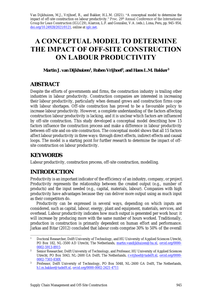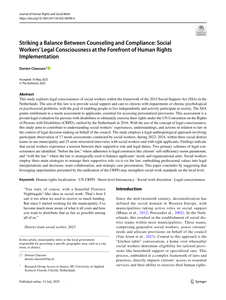Bio-based and circular building materials and techniques can play an important role in the transition toward a more sustainable construction sector. This study focuses on the Northern Netherlands and explores those competencies (in terms of knowledge, skills, and attitude) required by construction workers to meet thechallenges of material transition. The perspectives on this topic of construction companies, vocational education institutions, and local networking initiatives have been collected and analyzed by using the thematic analysis method. The results indicate that the limited knowledge availability, combined with the restricted experimentation possibilities, shape the current experiences, as well as the positioning of these stakeholders, regarding the desired competencies of construction workers. It is found that mainly attitudinal aspects of the construction workers need to receive particular attention and prioritization. To achieve that, the results highlight the importance of knowledge exchange and awareness-raising initiatives, as well as the development of a flexible, regional, and comprehensive learning environment.
DOCUMENT

From the article: Abstract. This exploratory and conceptual article sets out to research what arguments and possibilities for experimentation in construction exists and if experimentation can contribute towards more innovative construction as a whole. Traditional, -western- construction is very conservative and regional, often following a traditional and linear design process, which focuses on front-loaded cost savings and repetitive efficiency, rather than securing market position through innovation. Thus becoming a hindrance for the development of the sector as a whole. Exploring the effects of using the, in other design-sectors commonly and successfully practiced, “four-phased iterative method” in architectural construction could be the start of transforming the conservative construction industry towards a more innovative construction industry. The goal of this research is to find whether the proposed strategy would indeed result in a higher learning curve and more innovation during the - architectural- process. Preliminary research indicates that there is argumentation for a more experimental approach to construction.
DOCUMENT

The importance of specific professions for human rights realization is increasingly recognized. Journalists, teachers, and civil servants are all considered to play a role because their work affects individual rights. This is also the case for social workers. The connection between social work and human rights is evident in the large amount of literature explaining how human rights relate to social work. At the same time there is more attention for human rights localization. These fields of knowledge are related: social workers are local professionals and if they start applying human rights in their work this may influence human rights localization. This article contributes to existing debates on human rights localization by reflecting on the potential role of social workers in local human rights efforts in the Netherlands. Since human rights localization in general and human rights application in social work are recent phenomena in the Netherlands this provides a useful case study for a qualitative analysis on whether and how social workers can be regarded as actors in human rights localization. By connecting different actors that are said to play a role in human rights localization to proposed forms of human rights application by social workers this article identifies three possible roles for social workers in human rights localization: as human rights translators, as human rights advocates, and as human rights practitioners.
MULTIFILE

Despite the efforts of governments and firms, the construction industry is trailing other industries in labour productivity. Construction companies are interested in increasing their labour productivity, particularly when demand grows and construction firms cope with labour shortages. Off-site construction has proved to be a favourable policy to increase labour productivity. However, a complete understanding of the factors affecting construction labour productivity is lacking, and it is unclear which factors are influenced by off-site construction. This study developed a conceptual model describing how 15 factors influence the construction process and make a difference in labour productivity between off-site and on-site construction. The conceptual model shows that all 15 factors affect labour productivity in three ways: through direct effects, indirect effects and causal loops. The model is a starting point for further research to determine the impact of off-site construction on labour productivity.
MULTIFILE

This literature review explores ways older workers might continue to make waves and impact their work organization. The topic of the paper is grounded in the problem of an ageing organizational population looming in the near future. The work presented here is a start to helping management in knowledge-intensive organizations to understand how to effectively utilize the capacities of older knowledge workers by stimulating intergenerational learning as a means to retain critical organizational knowledge, encourage innovation and promote organizational learning through knowledge building. First, the concept of intergenerational learning is developed followed by a discussion of the organizational factors important for it to take place. The last section presents ideas on how to design and implement intergenerational learning as an organizational development program.
MULTIFILE

The purpose of this paper is to lay the groundwork for a large-scale prescriptive research project on organizing intergenerational communities of practice as a way to help organizations deal with some of the problems an ageing worker population brings with it. After a definition of the problem, a review of four seminal works on communities of practice was done to see if organizing intergenerational communities of practice might in fact be a viable solution to the problems of an ageing organizational population. Results are encouraging and lead to the conclusion that management might start to consider organizing these communities as a way to shed new light on older workers.
MULTIFILE

Dealing with and maintaining high-quality standards in the design and construction phases is challenging, especially for on-site construction. Issues like improper implementation of building components and poor communication can widen the gap between design specifications and actual conditions. To prevent this, particularly for energy-efficient buildings, it is vital to develop resilient, sustainable strategies. These should optimize resource use, minimize environmental impact, and enhance livability, contributing to carbon neutrality by 2050 and climate change mitigation. Traditional post-occupancy evaluations, which identify defects after construction, are impractical for addressing energy performance gaps. A new, real-time inspection approach is necessary throughout the construction process. This paper suggests an innovative guideline for prefabricated buildings, emphasizing digital ‘self-instruction’ and ‘self-inspection’. These procedures ensure activities impacting quality adhere to specific instructions, drawings, and 3D models, incorporating the relevant acceptance criteria to verify completion. This methodology, promoting alignment with planned energy-efficient features, is supported by BIM-based software and Augmented Reality (AR) tools, embodying Industry 4.0 principles. BIM (Building Information Modeling) and AR bridge the gap between virtual design and actual construction, improving stakeholder communication and enabling real-time monitoring and adjustments. This integration fosters accuracy and efficiency, which are key for energy-efficient and nearly zero-energy buildings, marking a shift towards a more precise, collaborative, and environmentally sensible construction industry.
DOCUMENT

This paper proposes and showcases a methodology to develop an observational behavior assessment instrument to assess psychological competencies of police officers. We outline a step-by-step methodology for police organizations to measure and evaluate behavior in a meaningful way to assess these competencies. We illustrate the proposed methodology with a practical example. We posit that direct behavioral observation can be key in measuring the expression of psychological competence in practice, and that psychological competence in practice is what police organizations should care about. We hope this paper offers police organizations a methodology to perform scientifically informed observational behavior assessment of their police officers’ psychological competencies and inspires additional research efforts into this important area.
MULTIFILE

This study explores legal consciousness of social workers within the framework of the 2015 Social Support Act (SSA) in the Netherlands. The aim of this law is to provide social support and care to citizens with impairments or chronic psychological or psychosocial problems, with the goal of enabling people to live independently and actively participate in society. The SSA grants entitlement to a needs assessment to applicants, essential for accessing personalized provisions. This assessment is a pivotal legal evaluation for persons with disabilities to ultimately exercise their rights under the UN Convention on the Rights of Persons with Disabilities (CRPD), ratified by the Netherlands in 2016. With the use of the concept of legal consciousness, this study aims to contribute to understanding social workers’ experiences, understandings, and actions in relation to law in the context of legal decision-making on behalf of the council.
MULTIFILE

The aim of this exploratory study was to assess whether practicing social workers currently enrolled in Master Social Work (MSW) programs (hereafter referred to as MSW students) were more oriented to the evidence-based practice (EBP) process and more engaged in it than practicing social workers who are not currently enrolled in MSW programs (hereafter referred to as social workers) in the Netherlands. Data were collected from MSW students (n = 32) and from social workers (n = 341) using the EBP Process Assessment Scale. MSW students reported a stronger orientation toward the EBP process, more positive attitudes toward EBP, more familiarity with EBP and more intentions to engage in EBP than social workers did, however, they were less positive about the feasibility of implementing EBP in practice. These preliminary results suggest that there are grounds for optimism about MSW students’ acceptance of and engagement in the EBP process. Implications for social work education are discussed.
DOCUMENT
